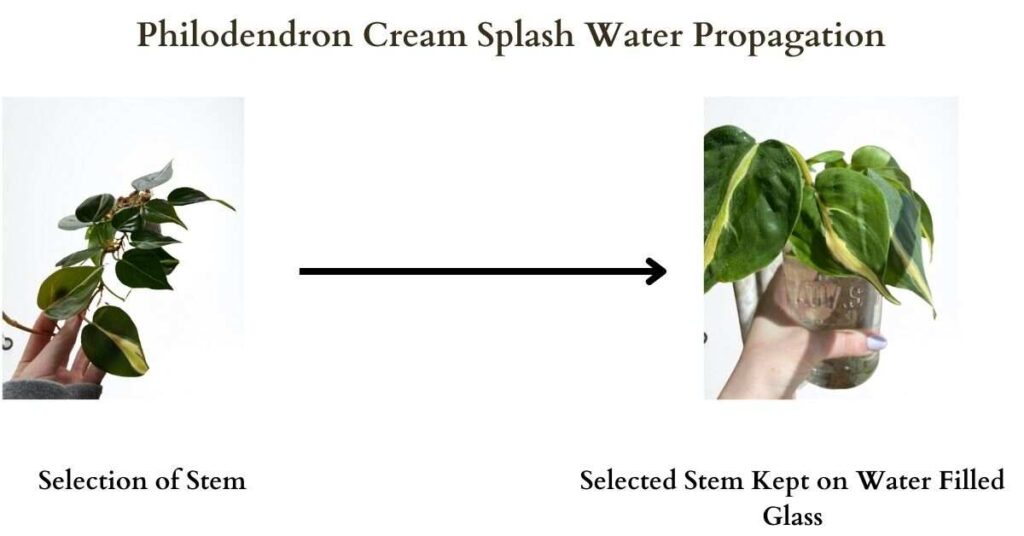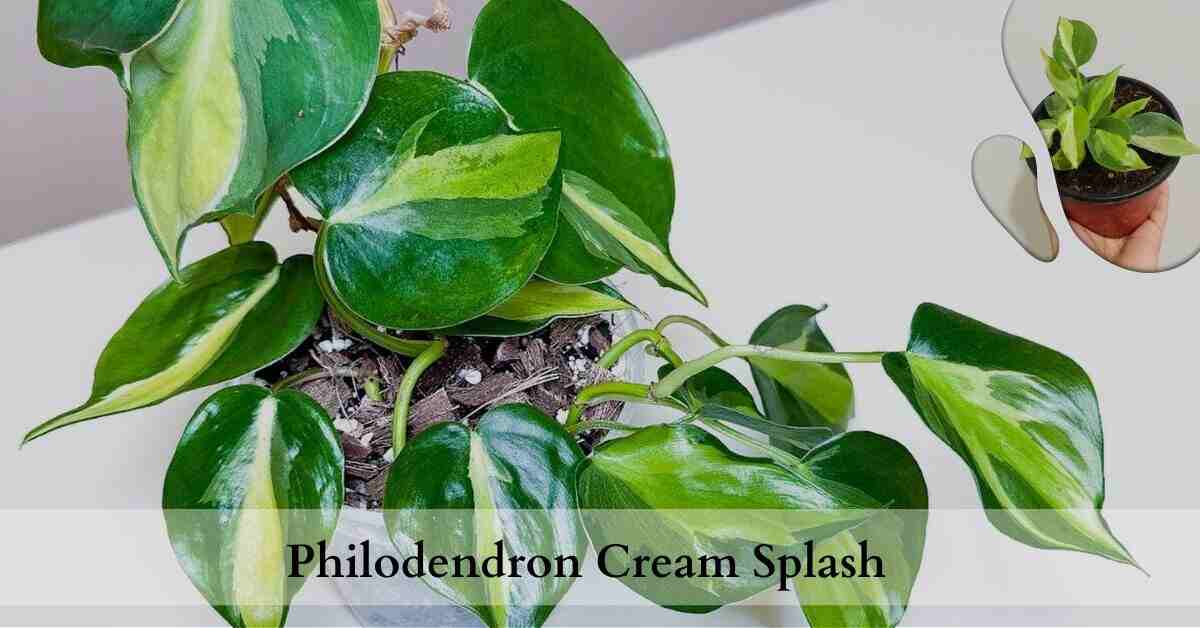Introduction
Among many genera of Philodendrons, Philodendron Cream Splash is a popular tropical plant preferred for its evergreen foliage. The plant is also known by the name of the sweetheart plant or heart-leaf due to its showy foliage. It is a vining plant that grows as a climber and does not require much care.

It can attain a height of 4 feet when grown under optimum growing conditions. The plant is native to the Caribbean, Mexico, and South and Central America. First of all this plant was documented in 2009. Philodendron cream splash is an excellent choice for beginners.
A quick overview of this plant is given below:-
| Plant Name | Philodendron Cream Splash |
| Other Name | Sweetheart plant or Heart-leaf Plant |
| Scientific Name | Philodendron |
| Origin | The Caribbean, Mexico, and South and Central America |
| Growing Zone | Coastal and tropical south zones |
| Grown For | Foliage Beauty |
| Plant Type | Tropical Vine |
| Height | 4 feet |
| Width | 2-3 feet |
| Tolerance | Low Light Conditions |
| Toxicity | Toxic to Pets and Children |
| Price | $30-$70 |
Botanical Classification
| Kingdom | Plantae |
| Superdivision | Spermatophyta |
| Subkingdom | Tracheobionta |
| Division | Magnoliophyta |
| Class | Liliopsida |
| Subclass | Arecidae |
| Order | Arales |
| Family | Araceae |
| Genus | Philodendron |
USDA Growing Zone
This plant grows in Coastal and tropical south zones. It is a plant from a warm, hot region. It is generally found in the USDA growing zone 9-11.
Philodendron Cream Splash vs Silver Stripe

Morphologically cream splash and silver stripe are similar. But the Philodendron Cream Splash has different variegation than the silver stripe. The cream splash has an irregular variegation pattern than the silver stripe. Silver stripe has silver variegation whereas cream splash has light green variegation. Also, the Silver stripe has darker leaves than the Cream Splash. The growing pattern of these plants is also different.
Philodendron Cream Splash vs Rio

The Cream Splash has more cream colour than Rio. Rio also contains silver stripes which alternate with cream and dark green colours.
Philodendron Cream Splash vs Gabby

The cream splash is greener in colour than Gabby. Gabby is more cream in colour.
Philodendron Cream Splash vs Brasil

The main difference is in the variegation of the leaves. Philodendron Cream Splash has got four colours on its leaves. The four colours include green, light green, cream and light yellow whereas Philodendron Brasil has bright yellow variegation. It grows in 3 colours.
Characters
Following are the morphological characteristics of Philodendron Cream Splash:
Leaves
This plant possesses glossy evergreen foliage. The foliage is light green to dark green. The leaves are variegated. Proper light and balanced fertiliser play a crucial role in imparting the variegation.
Flower
Flowering rarely occurs. Even if flowering occurs, flowers are unattractive.
Toxicity

This plant is toxic to both humans and pets. Philodendron Cream Splash possesses toxic calcium oxalate crystals. Due to the presence of toxic calcium oxalate crystals, it is highly toxic when ingested. If ingested it causes nausea and irritation. So, always put this plant away from the children and pets. If ingested it causes gastrointestinal upset in pets.
Philodendron Cream Splash Care
Philodendron cream splash plant prefers bright but indirect light. This plant can tolerate low light conditions but the growth slows under low illumination. It is a drought-tolerant plant and thrives well under low water conditions. Overwatering is detrimental to this plant as overwatering leads to the rotting of roots which may result in the death of the plant. Being a tropical plant it prefers wet and hot humid conditions. The optimum temperature ranges between 64 to 85 degrees Fahrenheit. For this plant well drained soil with high organic content serves as excellent growing media. This plant requires about 60 to 70 % humidity. However, the plant can tolerate humidity up to 50%. Fertilisation is required for obtaining proper growth of the plant. This plant needs to be fertilised once or twice during the active growing season i.e. spring and summer. As this is a fast-growing plant, it requires frequent pruning. Also, this plant should be repotted once in 18 to 24 months.
Also Read: Scindapsus Silver Lady: Ultimate Guide to Care and Propagation
Light
Being a tropical plant, it prefers bright indirect light. This plant can tolerate low light conditions but the growth is limited. Brighter windows receiving indirect light are the best location to keep this plant. Too much shade and direct sunlight hinder the growth and development of this plant.
Water
It prefers moist but not wet conditions. Watering should be done once a week. However, prevalent weather conditions may change the frequency of watering. Under dry conditions, misting is proved to be beneficial for this plant. This plant also tolerates drought conditions but the roots will rot under wet conditions. Under poor drainage conditions, roots will decay causing severe damage to the plant. If overwatered, the death of the plant may occur. During summer, humidifiers may be used to increase the humidity.
Temperature
As this plant originated from a tropical region, it prefers a warm climate. The optimum temperature ranges between 64 to 85 degrees Fahrenheit. Too cold during winter is detrimental for this plant as this is frost susceptible. You have to bring this plant indoors if the temperature falls below 55 degrees Fahrenheit during winter. However, too-hot conditions are detrimental to plants.
Soil
This plant can be grown in different kinds of soil. Well-drained soil with abundant organic matter serves as an excellent growing medium. Also, the soil should have good moisture-holding capacity. The potting mix prepared by mixing locally available soil with peat moss and coconut coir serves as good growing media. However, too much organic matter may cause undesirable results.
Humidity
This plant prefers high humidity. 60 to 70% humidity is considered best for this plant. This plant can tolerate humidity up to 40 % without any damage. For profuse growth, humidity should be maintained above 50 %. A humidity of more than 80% is also detrimental to this plant as it is conducive to many diseases and pests.
Fertiliser
During the warm season, the growth rate of plants is generally high. This plant should be fertilised according to its growth rate. So, before fertilising it is better to observe its growth pace. From spring to summer this plant must be fertilised at least two times. Use slow-release fertilisers, as they release nutrients slowly and hence provide the nutrient throughout the growing season. If nutrient deficiency symptoms appear, use liquid fertiliser as it provides nutrients quickly. However, over-fertilisation should be avoided. Also, do not fertilise the plant during winter. Fish emulsions and worm castings can also be used as fertiliser sources.
Potting and Repotting
For potting, use a pot of appropriate size and fill it with the potting mix. Then plant this plant on it. Water the plant once a week and keep it in bright but indirect light conditions. As it is a fast-growing plant, it should be repotted eventually. The repotting should be done within 18 to 24 months. Repotting must be done when there is a pot-bound condition. While repotting, a pot of bigger size should be selected.
Training and Pruning
Training is done to provide the desired shape to the plant. Training should be done from the beginning of the planting. As it is a fast-growing plant, it requires timely pruning. Pruning should be done to avoid the plant being meshy and bushy.
Propagation
This plant is easy to propagate. Stem cutting is mainly used for propagating this plant. Also, this plant can be propagated by seed. But it is difficult to propagate this plant from seed. For propagation from a stem cutting, we have to choose a healthy stem with at least one node and one or more leaves. Then cut it with sterilised scissors just below the node. Then the cutting can either be put on water or soil for rooting.
1. Water Propagation

First, take a container of appropriate size and fill it with water. Then place the cutting in the water and make sure that the nodes are submerged in water. Rooting will start after 7-10 days. It will take 3- 4 weeks for proper growth of roots. After the roots become 2-4 inches in length, you can transfer them to the soil.
2.Soil Propagation

Select the pot of appropriate size and fill it with a potting mix prepared by using locally available soil. The soil should be watered to make it moist. Then place the cutting on the soil. Make sure that nodes are below the soil surface. After that, the pot should be placed in an appropriate location receiving bright but indirect light. In 4-6 weeks rooting will be complete.
Price
It is more expensive than the other Philodendron species. Its price varies between $30-$70. However, the price varies according to place.
Common Problems
The following are the common disorders commonly faced by growers:
- Leggy stems
Inadequate light conditions lead to leggy stems. So, provide bright indirect light to the plant to avoid leggy stems.
- Small leaves
This is due to the lack of required growing conditions.
- Uneven growth
In this type of growth, plants have bushier growth on one side but empty spots on the other side.
- Wrinkled leaves
This is due to a phytotoxic reaction. The applied fertiliser and pesticides dry out and cause leaves to shrivel.
This plant is resistant to most pests and diseases. Aphids, spider mites and mealybugs are major pests of this plant. Root rot, leaf spot and powdery mildew are major diseases of this plant. Root rot is due to overwatering. So, avoid overwatering. The common symptoms are drooping and wilting of foliage.
Pros and Cons
| Pros | Cons |
| This is fast growing and easy to care. | It is toxic to both humans and pets. |
| It is resistant to most diseases and pests. | As it is a fast-growing plant, it requires frequent pruning and repotting. |
| It filters air by removing toxic gases. | Under low illumination, variegation may be lost. |
| Its attractive variegation is appealing. | |
| This is a drought-tolerant plant. |
Final Words
Philodendron Cream Splash is a fast-growing vine popular for its showy foliage. This evergreen plant originated in the tropical part of the world. As this plant requires less care, it is easier to grow this plant. Its evergreen foliage is light green to dark green. Flowering rarely occurs. Even when flowering occurs, flowers are unattractive. Being originated from the tropical region, this plant prefers warm and humid climatic conditions. The optimum temperature of this plant is 64 to 85 degrees Fahrenheit. It prefers humidity of 60 to 70 %. Humidity below 50% is detrimental to this plant. Also, this plant possesses toxic calcium oxalate crystals, so it is toxic to humans and pets. So, this plant should be kept away from children and pets. This is a fast-growing plant and it requires regular pruning. This is a drought-tolerant plant. So, it can also be grown under low water conditions. This plant is also resistant to many pests. This plant is mainly propagated by stem cutting.
Water or soil can be used as rooting media. If you are searching for the best plant to grow indoors, this may be an excellent choice for you.
FAQS
1. Is Philodendron Cream splash rare species?
It is not a rare plant. Despite being native to Central and South America it is becoming popular around the globe. This plant is commonly found in tropical regions where warm and humid climatic conditions prevail.
2. Will the Philodendron Cream splash revert?
Philodendron Cream Splash may revert if its requirements are not fulfilled. It will lose its variegation on the foliage under inadequate sunlight. Extreme hot or cold conditions are also detrimental to this plant.
3. Can we eat the Philodendron Cream splash?
As it contains toxic calcium oxalate crystals, we cannot eat this. If ingested it may cause vomiting, diarrhoea, burning sensation and pain. Also, it may cause swelling of the lips, and mouth. Chewing any part of this plant may cause difficulties in breathing. Also, if exposed to the skin it may cause skin irritation. So, while handling this plant you should wear protective clothing. So, never try to eat this plant.


